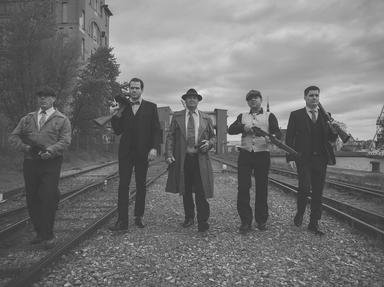Quiz Answer Key and Fun Facts
1. In 1942 Val Lewton was appointed as head of the RKO horror unit, where he was to produce the films that are most associated with his name. That same year, his first RKO film was released. "Cat People" starred Simone Simon as Irena, a woman who (justifiably) fears that she will transform into a member of the cat family if her passions are aroused. Into what feline does Irena transform when she becomes passionate?
2. In 1943 Val Lewton produced a film for RKO that had a plot clearly inspired by "Jane Eyre". A nurse caring for the catatonic wife of a plantation owner on a Caribbean island falls in love with the man, and determines to cure his wife. The wife may be ill, or insane, or possessed, or cursed. With plenty of voodoo references, including the eventful nighttime journey of the two women to Houmfort (please let me hold your hand while they pass the animal sacrifices, meet the zombie Carre-Four, and watch the Sabreur perform his rituals), what is this Lewton classic?
3. Val Lewton's third film for RKO was based on the book "Black Alibi" by Cornell Woolrich. Jerry Manning hires a large feline as a publicity stunt for his girlfriend Kiki to use in her nightclub act, but a jealous rival causes the animal to escape. As people start dying, we wonder whether or not it is the escaped animal (after whom the film is titled) that is responsible. What is the name of this film?
4. "The Seventh Victim", produced by Val Lewton for RKO in 1943, tells the story of Mary Gibson, a young woman who runs into an underground cult of Satanists in Greenwich Village, while searching for her missing sister. This film marked the screen debut of an actress who later won an Academy Award for Best Supporting Actress for her portrayal of Stella Kowalski in the 1951 film "A Streetcar Named Desire". I want to hold your hand to as we watch Mary discover that her sister's apartment contains only a chair and a noose hanging from the ceiling. What actress made this foreboding discovery?
5. A young merchant marine officer, named Tom Merriam, becomes convinced that the ship's captain is insane, but his crewmates believe the ship is haunted and cursed. After a number of mysterious deaths, Merriam is fired then (due to a misunderstanding) brought back to the ship, whereupon it becomes clear that his life is in danger. I would like a hand to hold during the scene in which the captain is killed by Finn, an illiterate crewman who has become embroiled in the mess. What 1943 movie produced by Val Lewton are we watching?
6. In 1944 Val Lewton produced a movie whose title suggested it was a sequel to his 1942 "Cat People". Marketed with the tagline 'The black menace creeps again', what film was this?
7. "Youth Runs Wild" is a 1944 Val Lewton movie about unattentive parents and juvenile delinquency. While it is not a horror movie, there are some scenes of violence that make me want to hold someone's hand as I watch. Which of the following scenes did the studio cut, on the grounds that it was too controversial?
8. In 1945 Val Lewton directed "The Body Snatcher", a horror film based on the Robert Louis Stevenson short story with the same title. This film featured an actor who is better known for his portrayal of Frankenstein's monster. Who played the role of cabman John Gray?
9. Val Lewton's 1945 film "Isle of the Dead" is set on a Greek island during the First Balkan War (1912-1913). When people start dying, the island is quarantined because of suspected plague. But a vrykolakas is also suspected of roaming the night, and young Thea's life is in danger as The General becomes convinced that she must be killed to save them all. What supernatural creature beloved of horror films does a vrykolakas most closely resemble?
10. Val Lewton's final film for RKO was inspired by the final painting ("The Madhouse") of William Hogarth's series of paintings titled "A Rake's Progress", and Hogarth is given a writing credit. The painting shows the central character insane and violent, and confined to Bethlehem Hospital, London's most celebrated mental asylum of the 18th century. The nickname of this institution provided the film's title. What was it?
Source: Author
looney_tunes
This quiz was reviewed by FunTrivia editor
skunkee before going online.
Any errors found in FunTrivia content are routinely corrected through our feedback system.


